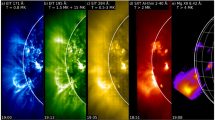Abstract
The rays of enhanced brightness making up the structure of the coronal-streamer belt can be traced to the lowest atmospheric layers in the Sun, with the angular size remaining nearly constant, d ≈ 2.5° ± 0.5°. This suggests that the physical mechanism generating the slow solar wind in the rays of the streamer belt differs from the mechanism giving rise to the fast solar wind from coronal holes. At distances of R < (4–5) R ⊙, the rays of the streamer belt are not radial in the plane of the sky and show deviations toward the corresponding pole. They then become essentially radial at R > (4–5) R ⊙. A transverse cross section of streamers in the corona and its continuation into the heliosphere—a plasma sheet—can be represented as two radially oriented, closely spaced rays (d ≈ 2.0°–2.5°) with enhanced density and an angular size of d. We also show that the ray structure of the streamer belt is involved in the development of coronal mass ejections (CMEs). The motion of a small-scale CME occurs within a magnetic flux tube (ray of enhanced brightness) and leads to an explosive increase in its angular size (rapid expansion of the tube). It seems likely that large-scale CMEs are the result of the simultaneous expansion of several magnetic tubes. We suggest that a small-scale CME corresponds to a “plasmoid” (clump of plasma of limited size with its own magnetic field) ejected into the base of a magnetic tube, which subsequently moves away from the Sun along the tube.
Similar content being viewed by others
References
S. K. Vsekhvyatskii, G. M. Nikol’skii, V. I. Ivanchuk, et al., Solnechnaya korona i korpuskulyarnoe izluchenie v mezhplanetnom prostranstve (Corona and Corpuscular Radiation in Interplanetary Space) (KU, Kiev, 1965) [in Russian].
G. Newkirk, Ann. Rev. Astron. Astrophys. 5, 213 (1967).
R. A. Howard, M. A. Koomen, D. J. Michels, et al., Synoptic Observations of the Solar Corona during Carrington Rotations 1580–1596, Report UAG-48, World Data Center for Solar—Terrestrial Physics (July 1975).
J. D. Bohlin, Sol. Phys. 12, 240 (1970).
L. Svalgaard, J. M. Wilcox, and T. L. Duvall, Sol. Phys. 37, 157 (1974).
N. P. Korzhov, Sol. Phys. 55, 505 (1977)
R. A. Gulyaev, Sov. Phys. Usp. 35, 1083 (1992).
V. G. Eselevich, J. Geophys. Res. 103, 2021 (1998).
O. G. Badalyan, Astron. Zh. 68, 602 (1991) [Sov. Astron. 35, 295 (1991)].
S. Koutchmy and M. Livshits, Space Sci. Rev. 61, 393 (1992).
V. G. Eselevich and M. V. Eselevich, Sol. Phys. 188, 299 (1999).
M. V. Eselevich and V. G. Eselevich, Astron. Zh. 81, 757 (2004) [Astron. Rep. 48, 688 (2004)].
L. Strachan, R. Suleiman, A. V. Panasyuk, et al., Astrophys. J. 571, 1008 (2002).
N. R. Sheeley, Jr., Y.-M. Wang, S. H. Hawley, et al., Astrophys. J. 484, 472 (1997).
Y.-M. Wang, N. R. Sheeley, Jr., R. A. Howard, et al., Geophys. Res. Lett. 26, 1349 (1999).
V. G. Eselevich and M. V. Eselevich, Sol. Phys. 203, 165 (2001).
T. G. Forbes, J. Geophys. Res. 105, 25 153 (2000).
R. M. Illing and A. J. Hundhausen, J. Geophys. Res. 91, 10951 (1986).
M. V. Eselevich and V. G. Eselevich, Astron. Zh. 82, 79 (2005) [Astron. Rep. 49, 71 (2005)].
V. M. Gubchenko, M. L. Khodachenko, H. K. Biernat, et al., Hvar Obs. Bull. 28, 127 (2004).
V. G. Eselevich and M. V. Eselevich, Sol. Phys. 197, 101 (2000).
G. Borrini, J. T. Gosling, S. J. Barne, et al., J. Geophys. Res. 86, 45 659 (1981).
V. G. Eselevich and V. G. Fainshtein, Planet. Space Sci. 40, 105 (1992).
B. Bavassano, R. Woo, and R. Bruno, Geophys. Res. Lett. 24, 1655 (1997).
Y.-M. Wang, N. R. Sheeley, Jr., N. R. Walters, et al., Astrophys. J. 496, L165 (1998).
C. Lacombe, C. Salem, A. Y. Mangeney, et al., Ann. Geophys. 18, 852 (2000).
V. G. Eselevich and M. V. Eselevich, in Proceedings of the All-Russia Conference Dedicated to the 90th Anniversary of Corr. Member of RAS V.E. Stepanov, Irkutsk, 2003, p. 30.
N. U. Crooker, C. L. Huang, S. M. Lamassa, et al., J. Geophys. Res. A 109, 03107 (2004).
N. U. Crooker, S. W. Kahler, D. E. Larson, et al., J. Geophys. Res. A 109, 03108 (2004).
V. G. Eselevich and M. V. Eselevich, Chin. J. Space Sci. 25, 321 (2005).
V. G. Eselevich and M. A. Filippov, Planet. Space Sci. 34, 1119 (1986).
M. V. Eselevich and V. G. Eselevich, Astron. Zh. 82, 79 (2005) [Astron. Rep. 49, 71 (2005)].
Y.-M. Wang and N. R. Sheeley, Jr., Astrophys. J. 355, 726 (1990).
Y.-M. Wang, Astrophys. J. 437, L67 (1994).
Y.-M. Wang, N. R. Sheeley, Jr., and D. G. Socker, J. Geophys. Res. 105, 25 133 (2000).
V. G. Eselevich and V. G. Fainshtein, Planet. Space Sci. 39, 737 (1991).
A. Dollfus and M.-J. Martres, Martres, Sol. Phys. 53, 449 (1977).
S. Koutchmy, Adv. Space Res. 14, 29 (1994).
K. P. Dere, G. E. Brueckner, R. A. Howard, et al., Sol. Phys. 175, 601 (1997).
V. G. Eselevich, V. G. Fainshtein, and M. V. Eselevich, Sol. Phys. 200, 259 (2000).
Author information
Authors and Affiliations
Additional information
Original Russian Text © M.V. Eselevich, V.G. Eselevich, 2006, published in Astronomicheskiĭ Zhurnal, 2006, Vol. 83, No. 9, pp. 837–852.
Rights and permissions
About this article
Cite this article
Eselevich, M.V., Eselevich, V.G. Some features of the streamer belt in the solar corona and at the Earth’s orbit. Astron. Rep. 50, 748–761 (2006). https://doi.org/10.1134/S1063772906090083
Received:
Accepted:
Issue Date:
DOI: https://doi.org/10.1134/S1063772906090083




